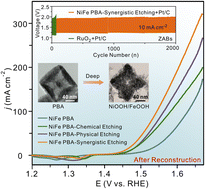Chemical–physical synergistic etching enabling deep reconstruction of NiFe Prussian blue analogue for efficient oxygen evolution reaction and Zn–air batteries†
Abstract
Prussian blue analogues (PBAs) are promising pre-catalysts for oxygen evolution reaction (OER) and the in situ reconstructed metal oxyhydroxides during OER are regarded as the real active sites. However, most of the reported PBAs only undergo surface reconstruction and the PBAs cannot be fully converted to active species, resulting in unsatisfactory activity. In this work, taking NiFe PBA nanocubes as an example, a chemical–physical synergistic etching strategy is developed to enable the deep reconstruction of NiFe PBA nanocubes, thus promoting the OER activity. After etching, the NiFe PBA nanocubes are converted to NiFe PBA nanoboxes with hollow structure and dual vacancies (Ni vacancy and CN vacancy), facilitating the deep reconstruction of NiFe PBAs to NiOOH/FeOOH nanoboxes. Benefiting from the structural and compositional merits, the NiOOH/FeOOH nanoboxes exhibit a low overpotential of 216 mV at 10 mA cm−2 in 1.0 M KOH. Furthermore, the assembled Zn–air battery based on NiOOH/FeOOH nanoboxes delivers high peak power density (185 mW cm−2) and superb cycling stability (over 2000 cycles at 10 mA cm−2), outperforming the commercial RuO2.

- This article is part of the themed collection: Journal of Materials Chemistry A HOT Papers


 Please wait while we load your content...
Please wait while we load your content...